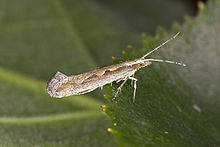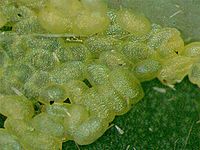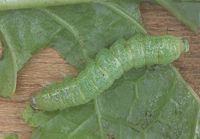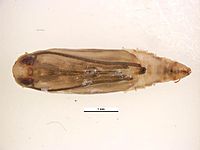- Diamondback moth
-
- "Diamondback moth" may also refer to the ermine moth genus Scythropia.
Diamondback moth 
Scientific classification Kingdom: Animalia Phylum: Arthropoda Class: Insecta Order: Lepidoptera Family: Plutellidae Genus: Plutella Species: P. xylostella Binomial name Plutella xylostella
(Linnaeus, 1758)Synonyms - Phalaena tinea xylostella (Linnaeus, 1758)
- Cerostoma xylostella (Linnaeus, 1777)
- Cerostoma maculipennis (Curtis, 1832)
- Plutella maculipennis
- Plutella albovenosa (Walsingham, 1907)
The diamondback moth (Plutella xylostella), sometimes called cabbage moth, is a European moth believed to originate in the Mediterranean region that has since spread worldwide. The moth has a short life cycle (14 days at 25°C), is highly fecund and capable of migrating long distances.[1] It is one of the most important pests of cruciferous crops in the world and will usually only feed on plants that produce glucosinolates.[1] However, not all of these plants are equally useful as hosts to the moth; there has been some discussion[2] of using wintercress as a buffer plant around agricultural fields as diamondback moths are highly attracted to that plant but their eggs fail to survive when oviposited on it.
Contents
Distribution
The diamondback moth has a global distribution and is found in Europe, Asia, Africa, the Americas, Australia, New Zealand and the Hawaiian islands.[3] It probably originated in Europe and was first observed in North America in 1854, in Illinois. It had spread to Florida and the Rocky Mountains by 1883 and was reported from British Columbia by 1905.[4]
Morphology
The diamondback moth has a wingspan of about fifteen milimetres and a body length of six milimetres. The fore wings are narrow, brownish-gray and lighter along the anterior margin, with fine dark speckles. There is a creamy-coloured stripe with a wavy edge on the posterior margin.[3] This band is sometimes constricted to form one or more light-colored diamond-shapes which is the basis for the common name of this moth. The hind wings are narrow, pointed toward the apex and light gray, with a wide fringe. The tips of the wings can be seen to turn upward slightly when viewed from the side. The antennae are pronounced.[4] The life span averages three to four weeks for females but rather less for males.[3] The moths are weak fliers seldom rising more than two metres above the ground and not flying long distances. They are however passive migrants, being easily transferred by wind over long distances.[3][4] Diamondback moths overwinter as adults among field debris of cruciferous crops and active adults may be seen during warm periods at any time during the winter in temperate areas.[5] They do not survive cold winters and re-invade colder areas each spring being carried there by the wind.[4] Moths are active usually at twilight and at night, feeding on flowers of cruciferous plants but they also fly in the afternoon during mass outbreaks.[3]
The eggs are oval and flattened, measuring 0.44 milimetres long and 0.26 milimetres wide. They are yellow or pale green at first but darken later.[3] They are laid singly or in groups of two to eight eggs in depressions on the surface of leaves. Females may deposit up to 300 eggs in total but average production is probably half that amount. The larvae emerge from the eggs in about six days.[4]
The larvae have four instars, each with an average development time of about four days. The larval body form tapers at both ends. The larvae have a few short black hairs and are colourless in the first instar but pale or emerald green with black heads in later instars.[5] There are five pairs of prolegs, one of which protrudes from the posterior end forming a distinctive "V". The larvae are quite active and when disturbed may wriggle violently, move backward and spin a strand of silk from which to dangle. The feeding habit of the first instar is leaf mining although they are so small that the mines are difficult to detect. The larvae emerge from these mines to moult and subsequently feed on the lower surface of the leaf. Their chewing results in irregular patches of damage though the upper leaf epidermis is often left intact.[4]
The yellowish pupae are about eight milimetres long and are wrapped in a loose silk cocoon. They are usually found on the lower or outer leaves of the food plant but on cauliflower and broccoli, pupation may occur in the florets. The pupal stage lasts on average for about eight days but ranges from five to fifteen days.[4]
Host plants
The diamondback moth lays its eggs only on plants in the family Brassicaceae. Nearly all cruciferous vegetable crops are attacked but some are favoured over others. These include broccoli, Brussels sprouts, cabbage, Chinese cabbage, cauliflower, collard, kale, kohlrabi, mustard, radish, turnip and watercress. Several wild species in the family also act as hosts, especially early in the season when cultivated crops are unavailable.[4]
Economic significance
Larvae damage leaves, buds, flowers, and seed-buds of cultivated cruciferous plants. Although the larvae are small, they can be very numerous and cause complete removal of foliar tissue except for the leaf veins. This is damaging to young seedlings and may disrupt head formation in cabbage, broccoli and cauliflower. The presence of larvae in florets can result in complete rejection of the produce. The diamondback moth is considered a pest in areas that do not experience very cold winters, as these help to kill off overwintering moths.[1] Control used to be through the use of chemical insecticides but in the 1980s resistance developed[6] to pyrethroids and soon afterwards, virtually all insecticides became ineffective. A decrease in insecticide use, and particularly elimination of pyrethroid use, can help by favoring survival of the parasitoids, Microplitis plutellae, Diadegma insulare and Diadromus subtilicornis.[4] The parasitoid Cotesia plutellae is reared in laboratories and released for the control of diamondback moth as part of Integrated Pest Management programmes in several countries (e.g; Mauritius).
The diamondback moth was the first insect that was found to have become resistant to biological control by the Bt toxin (Bacillus thuringiensis) in the field. Trichoplusia ni (Cabbage looper) is the only other insect to have developed resistance to Bt toxin in agricultural systems, specifically in greenhouses.[7][8]
References
- ^ a b c N. S. Talekar & A. M. Shelton (1993). "Biology, ecology and management of the diamondback moth". Annual Review of Entomology 38: 275–301. doi:10.1146/annurev.en.38.010193.001423.
- ^ F. R. Badenes-Perez, B. A. Nault & A.M. Shelton (2006). "Dynamics of diamondback moth oviposition in the presence of a highly preferred non-suitable host". Entomologia Experimentalis et Applicata 120 (1): 23–31. doi:10.1111/j.1570-7458.2006.00416.x.
- ^ a b c d e f AgroAtlas
- ^ a b c d e f g h i University of Florida
- ^ a b Oklahoma State University
- ^ Evaluation of selected insecticides for control of diamondback moth and cabbage looper.
- ^ A. F. Janmaat & J. Myers (2003). "eRapid evolution and the cost of resistance to Bacillus thuringiensis in greenhouse populations of cabbage loopers, Trichoplusia ni". Proceedings of the Royal Society B 270 (1530): 2263–2270. doi:10.1098/rspb.2003.2497.
- ^ P. Wang, J. Z. Zhao, A. Rodrigo-Simon, W. Kain, A. F. Janmaat, A. M. Shelton, J. Ferre & J. Myers (2006). "Mechanism of resistance to Bacillus thuringiensis toxin Cry1Ac in a greenhouse population of cabbage looper, Trichoplusia ni". Applied and Environmental Microbiology 73 (4): 1199. doi:10.1128/AEM.01834-06.
External links
- diamondback moth on the UF / IFAS Featured Creatures Web site
- [1] University of Technology, Sydney.
Categories:- Plutellidae
- Agricultural pest insects
- Animals described in 1758
Wikimedia Foundation. 2010.



